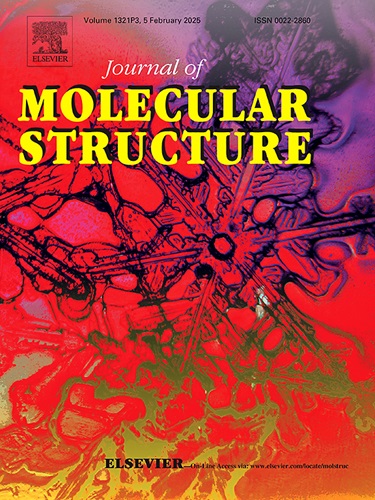硫脲和叔膦配体衍生的汞(II)、钯(II)和铂(II)配合物的储氢能力和计算研究
IF 4
2区 化学
Q2 CHEMISTRY, PHYSICAL
引用次数: 0
摘要
本研究在中性介质中,以两摩尔的配体CPPTH2或MPPTH2与一摩尔的HgCl2反应,合成了[Hg(Cl2)(CPPTH2)2](1)和[Hg(Cl2)(MPPTH2)2](2)配合物。通过一锅合成方案合成了[PdCl(CPPTH)PPh3](3)、[PtCl(CPPTH)PPh3](4a)、[Pt(CPPT)(PPh3)2](4b)。用FTIR、1H-、31-P核磁共振对所制备的配合物进行了表征,结果证实了所提出的结构。计算研究表明配合物(1)和配合物(2)由于其HOMO-LUMO间隙(3.95和4.10 eV)是稳定的配合物,NBO分析证明配体与金属电荷转移,而MEP分析表明配合物(1)具有更强的亲核性和更多的负电位。此外,还测试了配合物[Hg(CPPTH)2](1)和[Hg(MPPTH)2](2)的储氢能力。结果表明,这两种配合物都具有不同比例的储氢能力。测量结果表明,配合物[Hg(CPPTH)2](1)在65 bar和77 K下能够储存4 wt %,而配合物[Hg(MPPTH)2](2)在52 bar下能够储存0.91 wt %。本文章由计算机程序翻译,如有差异,请以英文原文为准。

Hydrogen storage capacity and computational studies of mercury(II), palladium (II) and platinum (II) complexes derived from thiourea and tertiary phosphine ligands
In this study, The complexes [Hg(Cl2)(CPPTH2)2] (1) and [Hg(Cl2)(MPPTH2)2] (2), were synthesized by reacting two moles of the ligand CPPTH2 or MPPTH2 with one mole of HgCl2 in a neutral medium. Moreover, [PdCl(CPPTH)PPh3](3), [PtCl(CPPTH)PPh3](4a), [Pt(CPPT)(PPh3)2](4b) were synthesized through a one pot synthesis protocol. The as-prepared complexes were characterized by FTIR, 1H-, 31-P nmr and the results prove the suggested structures. The computational studies revealed that both complex (1) and complex (2) are stable complexes due to their HOMO-LUMO gaps (3.95 and 4.10 eV), and the NBO analysis proves ligand to metal charge transfer while MEP analysis demonstrates that complex (1) was the stronger nucleophilic character with more negative potential. Furthermore, the ability of the complexes [Hg(CPPTH)2] (1) and [Hg(MPPTH)2] (2) to store hydrogen was tested. The results proved that both complexes have the ability to store hydrogen in different proportions. The measurement proved that the complex [Hg(CPPTH)2] (1) has the ability to store 4 wt % at 65 bar and 77 K while the complex [Hg(MPPTH)2](2) showed the ability to store 0.91 wt % at 52 bar.
求助全文
通过发布文献求助,成功后即可免费获取论文全文。
去求助
来源期刊

Journal of Molecular Structure
化学-物理化学
CiteScore
7.10
自引率
15.80%
发文量
2384
审稿时长
45 days
期刊介绍:
The Journal of Molecular Structure is dedicated to the publication of full-length articles and review papers, providing important new structural information on all types of chemical species including:
• Stable and unstable molecules in all types of environments (vapour, molecular beam, liquid, solution, liquid crystal, solid state, matrix-isolated, surface-absorbed etc.)
• Chemical intermediates
• Molecules in excited states
• Biological molecules
• Polymers.
The methods used may include any combination of spectroscopic and non-spectroscopic techniques, for example:
• Infrared spectroscopy (mid, far, near)
• Raman spectroscopy and non-linear Raman methods (CARS, etc.)
• Electronic absorption spectroscopy
• Optical rotatory dispersion and circular dichroism
• Fluorescence and phosphorescence techniques
• Electron spectroscopies (PES, XPS), EXAFS, etc.
• Microwave spectroscopy
• Electron diffraction
• NMR and ESR spectroscopies
• Mössbauer spectroscopy
• X-ray crystallography
• Charge Density Analyses
• Computational Studies (supplementing experimental methods)
We encourage publications combining theoretical and experimental approaches. The structural insights gained by the studies should be correlated with the properties, activity and/ or reactivity of the molecule under investigation and the relevance of this molecule and its implications should be discussed.
 求助内容:
求助内容: 应助结果提醒方式:
应助结果提醒方式:


